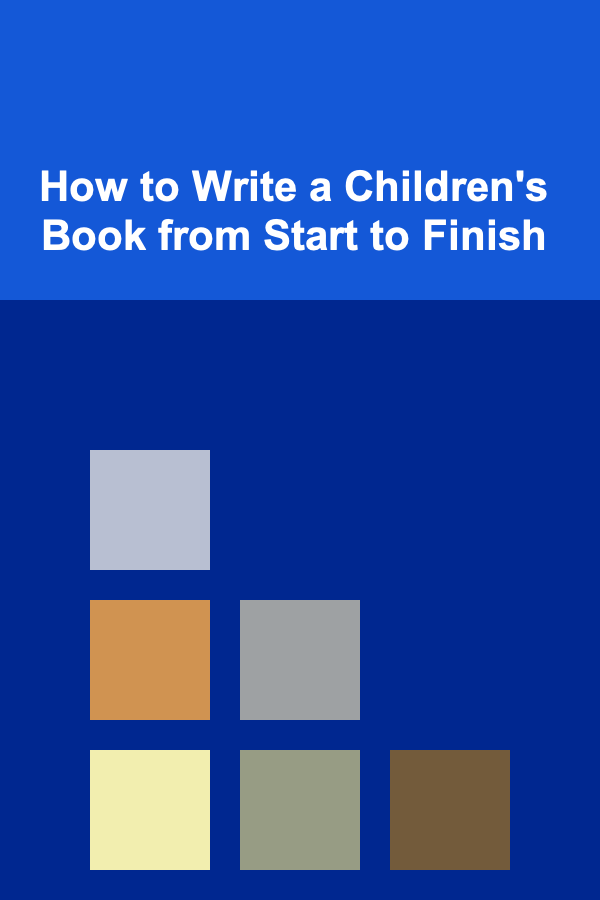
How to Write a Children's Book from Start to Finish
ebook include PDF & Audio bundle (Micro Guide)
$12.99$9.99
Limited Time Offer! Order within the next:

Writing a children's book is a rewarding creative endeavor, but it can also be challenging. The world of children's literature is vast, and creating a book that engages young readers while also meeting the standards of publishers and parents requires a deep understanding of both your audience and the craft. Whether you are writing for toddlers, young children, or older kids, the process of writing a children's book can be broken down into manageable steps.
In this article, we'll explore the essential elements of writing a children's book, from brainstorming ideas to revising the final manuscript. By the end, you'll have a clear understanding of the steps involved in creating a compelling and age-appropriate story.
Understanding Your Audience
Before you begin writing, it's crucial to understand the age group you are writing for. Children's books are categorized based on the developmental stages of children, and understanding these categories will help you craft a story that resonates with young readers.
Age Categories in Children's Literature
- Infants and Toddlers (0-3 years): Books for this age group typically consist of simple, engaging stories with lots of pictures and minimal text. The language is usually repetitive and rhythmic to help build early literacy skills.
- Preschool (3-5 years): Stories for this age range can be slightly more complex, with a clear narrative arc and repetitive structures that encourage children to predict and participate. Vocabulary should still be simple, but the storylines can introduce elements of conflict and resolution.
- Early Elementary (5-7 years): Books for children in this category can have more words and fewer pictures. The stories are more structured, often revolving around a problem that the protagonist must solve. Simple chapters may begin to appear in books for this age group.
- Middle Grade (8-12 years): Middle grade books feature more complex plots, multiple characters, and deeper emotional themes. The language is still accessible, but the content deals with more significant life experiences and challenges that resonate with older children.
- Young Adult (12-18 years): Though typically classified outside of children's literature, young adult books are often written with themes relevant to teenagers, exploring personal growth, identity, relationships, and societal challenges.
Choosing the right age category for your book will determine your writing style, vocabulary, themes, and even the way you structure your narrative.
Brainstorming and Planning Your Story
Once you have a clear understanding of your target age group, it's time to start brainstorming ideas. The best children's books usually stem from simple but captivating concepts. Here are some strategies to help you get started:
Brainstorming Techniques
- Draw from Personal Experiences: Many classic children's stories are inspired by the author's personal life. Reflect on your own childhood experiences or observe the children in your life to understand the types of stories they enjoy and the emotions they experience.
- Create Memorable Characters: Children's books often feature characters that are easy to relate to or engage with. Think about animals, fantastical creatures, or even everyday objects that could come to life in a creative and exciting way.
- Start with a Lesson or Theme: Many children's books are designed to teach a lesson or explore a universal theme, such as friendship, honesty, courage, or empathy. If you want your book to have an educational angle, decide on the lesson you'd like to convey.
- Use Classic Tropes: There's a reason certain tropes (such as "underdog triumphs" or "animals with human qualities") remain popular in children's literature. Feel free to use these themes but put your own twist on them.
Outline Your Story
Once you have a general idea for your book, create an outline. An outline helps you organize your thoughts, set up the structure of the story, and ensure the pacing is right. For younger audiences, keeping the story relatively short with a clear beginning, middle, and end is crucial.
Creating a Story Arc
For every children's book, it's important to establish a compelling story arc. Here's a basic structure you can follow:
- Introduction: Introduce the protagonist, their world, and what they want or need. This part should be engaging and set the stage for what's to come.
- Conflict: Present a problem or challenge that the main character must face. This conflict should be simple but relevant to the character's emotional growth.
- Climax: The turning point of the story where the character faces their biggest challenge or makes a crucial decision.
- Resolution: The conflict is resolved, and the character has learned or changed in some way. The resolution should feel satisfying and appropriate for the target age group.
Writing the First Draft
Now that you have a clear plan, it's time to start writing your first draft. Writing for children requires simplicity, clarity, and rhythm. Keep these tips in mind while writing:
Tips for Writing for Children
- Use Simple Language: Younger readers benefit from short, easy-to-understand sentences. Avoid overly complex vocabulary and try to use words that are appropriate for their developmental stage.
- Make it Visual: Children's books are often heavily illustrated. While you may not be the illustrator, keep in mind that your writing should leave space for the illustrations to add meaning. Think about how your words can create vivid images in a child's mind.
- Be Playful with Language: Children love playful language, rhyming, repetition, and onomatopoeia. Don't be afraid to experiment with sound and rhythm in your writing.
- Engage Emotions: Strong emotional engagement helps children connect with the story. Focus on universal feelings like fear, joy, excitement, and curiosity.
Writing for Young Readers
When writing for very young readers (0-5 years), it's important to focus on rhythm and repetition. Repetitive phrases and structures help children anticipate what's coming next, encouraging them to engage with the story.
For older children (8-12 years), the story can be more complex, but the language should remain straightforward and accessible. Consider the emotional depth and character development that would resonate with this age group.
Incorporating Illustrations
Illustrations are a huge part of children's books. They not only break up the text but also provide context, enhance the emotional tone, and add visual storytelling elements.
- Collaborating with an Illustrator: If you're not an illustrator, you'll need to collaborate with one. Consider how the illustrations will support your narrative and how you can work together to bring the world of your story to life.
- Understanding Illustration Styles: Children's book illustrations come in many styles---cartoonish, realistic, abstract, or whimsical. The style of the illustrations should complement the tone and themes of your story.
Revising and Editing Your Manuscript
After completing your first draft, the revision process begins. Writing a children's book involves a great deal of trimming and fine-tuning. Here's what to focus on during the revision stage:
Key Areas to Revise
- Pacing: Make sure your story moves at a steady pace. Children's books, especially for younger readers, should be engaging from start to finish without any long or tedious sections.
- Consistency: Check for consistency in character development, plot progression, and language use. If your protagonist starts with one set of characteristics, make sure they evolve logically throughout the story.
- Clarity: Ensure your story is clear and easy to follow. Avoid overly complex subplots or confusing language.
- Dialogue: If your book contains dialogue, ensure that it sounds natural and is age-appropriate. Dialogue should be used to move the story forward or reveal character traits.
Getting Feedback
Once you've made revisions, seek feedback from others. This could be from parents, teachers, children's book editors, or even children themselves (if possible). Their insights will help you fine-tune your manuscript further.
Finding a Publisher or Self-Publishing
After your manuscript is polished, you have two main options for publishing: traditional publishing or self-publishing.
- Traditional Publishing: Submit your manuscript to publishers who specialize in children's books. Some publishers may require you to work with an agent, while others accept unsolicited submissions. Research the right publishers for your book and follow their submission guidelines carefully.
- Self-Publishing: If you prefer more control over the process, self-publishing may be a viable option. There are many platforms that allow you to publish and distribute your book digitally or in print.
Marketing and Distribution
Once your book is published, it's time to get it into the hands of readers. Here are a few marketing strategies for children's books:
- Author Website and Social Media: Create a website and social media profiles to promote your book and engage with your audience.
- Book Readings and School Visits: Hosting readings or offering to visit schools can help promote your book to children and parents.
- Book Reviews: Reach out to book reviewers, bloggers, and influencers who specialize in children's literature to get the word out.
Writing a children's book is a fulfilling journey that requires patience, creativity, and attention to detail. By understanding your audience, developing a strong story, and collaborating with illustrators and publishers, you can create a book that will capture the imaginations of young readers for years to come. Happy writing!
Reading More From Our Other Websites
- [Personal Care Tips 101] How to Choose the Best Natural Deodorant Options for Your Lifestyle
- [Personal Care Tips 101] How to Use Lip Balm to Prevent Dryness and Cracks in Hot Weather
- [Home Maintenance 101] How to Maintain and Clean Your Home's Dishwasher for Optimal Performance
- [Home Holiday Decoration 101] How to Add a Pop of Color to Your Holiday Decorations
- [Home Staging 101] How to Stage Your Home to Sell Faster and for More Money
- [Organization Tip 101] How to Set Up a Carpool System for Smooth Rides
- [Home Renovating 101] How to Design a Functional and Stylish Home Office During Renovation
- [Personal Care Tips 101] How to Make Your Teeth Whitening Strips Last Longer
- [Soap Making Tip 101] Best Recipes for Zero‑Waste Soap Using Kitchen Scraps
- [Home Holiday Decoration 101] How to Store Holiday Decor Year-Round with Practical and Creative Solutions

How to Analyze Crime Rates in Your Area Before Moving
Read More
How to Save Money on Insurance Premiums
Read More
How to Use Color-Coding to Organize Your Emergency Kit
Read More
How To Limit Data Collection from Public Wi-Fi
Read More
How to Calm Your Mind with Breathwork
Read More10 Tips for Minimizing Capital Gains Taxes Through Strategic Tracking
Read MoreOther Products

How to Analyze Crime Rates in Your Area Before Moving
Read More
How to Save Money on Insurance Premiums
Read More
How to Use Color-Coding to Organize Your Emergency Kit
Read More
How To Limit Data Collection from Public Wi-Fi
Read More